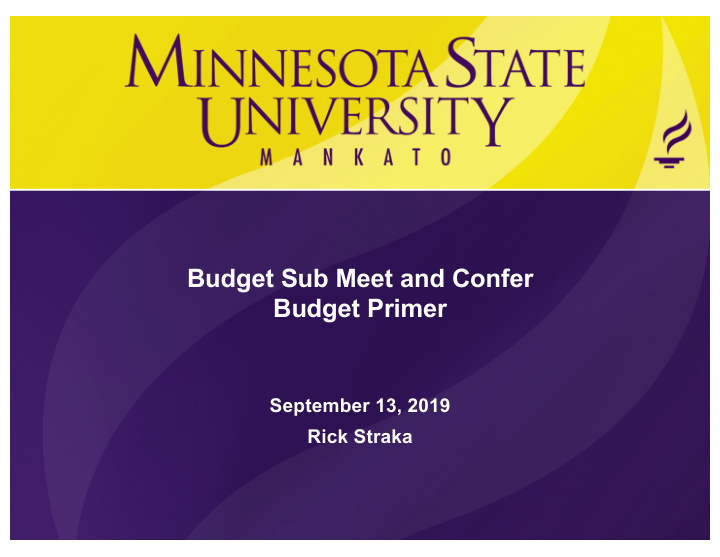



Budget Sub Meet and Confer Budget Primer September 13, 2019 Rick Straka
Presentation Topics 1. Tuition vs. Fees – What is the difference? 2. Types of Fees – What are they and why? 3. Fund types – What are they? 4. What role does foundation play in budget? 5. Trends in State Appropriation 6. General Budget Update 7. Capital Budget/Building Updates 8. Q&A
Tuition vs. Fees w Tuition o Major source of General Fund revenues along with State Appropriations o General Fund § Core Instructional and Operational budgets o Tuition does NOT fund: § Parking related expenses § Student Union operations or debt service § Residence Life operations or debt service § Student Activity operations
Tuition vs. Fees w Fees o Defined and authorized by MinnState Board Policy 5.1.1 o http://www.mnscu.edu/board/policy/511.html o http://www.mnscu.edu/board/procedure/511p1.html o Fee revenues are restricted for specific uses based upon above MinnState Policy and Procedure
Tuition Procedure 5.11.1 w Subpart C. Differential course and program tuition Colleges and universities may charge tuition by course or program when special circumstances exist. These circumstances may include but are not limited to an extraordinary cost of offering the course or academic program (e.g., need for specialized equipment and supplies; accreditation standards; delivery methods, e.g., off site locations, online, clinical experience) or a desire to incent enrollment in a specific course or program.
Tuition Procedure 5.11.1 w Subpart D. Market driven tuition Colleges and universities may set and charge market driven tuition for customized training, continuing education, graduate programs , fully online undergraduate programs , non- resident/non-reciprocity, international , non-credit instruction, and contract post-secondary enrollment options.
Totally Online New Programs
Types of Fees w Mandatory Fees o Senior citizen fee in lieu of tuition, Parking fee, Late fee, Payment plan fee, Statewide student association fee. w Optional Fees o Application fee, Credit for prior learning assessment fee, Student life/activity fee, Athletics fee, Health services fee, Special events fee, Residential learning community fee, Technology fee w Personal property charges and service charges w Revenue Fund fees
Major Fund Types w General fund o Tuition and Appropriation, Primary university operations w Student Activity Fund o Student Fee Funded activities w Revenue Funds o Student Union, Residential Life (Room and Board), Outdoor Rec Fee ♦ Auxiliary Funds o Parking, Bookstore
MSU Budget Process w Operating Budget is Primarily Incremental in Nature (Gen Fund, Student Fees, Room and Bd) < Last Year’s Base +/- Incremental Change w Incremental Change Aligned with Strategic Goals < Mandated/Required Changes Also Considered w Legislative and Bargaining Changes Challenging < Biennial Budget Finalized 6 weeks prior to Biennium Start < Bargaining Agreements Often Settled Late in Biennium
Gen Fund Budget Subcategories w Basic Operations < Base +/- Incremental w Equipment < 40% Base, 60% Zero Based w Strategic Priority < Zero Based w Repair and Betterment < Zero Based
Other Fund Types w Federal Grants w State Grants w Private Grants w Financial Aid Funds w Agency Funds
University Gen Fund Reserves w MinnState Required Undesignated Reserves of 5% - 7% of prior year Gen Fund Revenues w Goal of Minimum Year End Cash Balance of 20% of Gen Fund Revenues
Gen Fund Reserve Uses w Unanticipated Revenue Shortfalls or Expenses w Bridge Funding for a Short Term Transition to Balance Base Budgets w One-Time Investments (Operating or Capital) w NOT for Funding Ongoing Deficit Spending
Role of Foundation w Primary Role of Foundation o Scholarship Support via Annual Gifts and Endowment Earnings w Secondary Role o Restricted Purpose Gifts ♦ Foundation revenues are not a material source of unrestricted General Fund Budget
State Appropriation Trends w Historic state funding goal o 2/3 Appropriation, 1/3 Tuition o Current Funding o Approximately 1/3 Appropriation, 2/3 Tuition o Fifteen year trend has been steadily declining state support. There has been an increase in last three biennium which partially supported tuition freezes in 4 of last 6 years (FY14-FY19). Unlikely to return to historic funding goal.
FY19 Review w Budget was approximately $4M in deficit prior to Investments and Reallocation/Reductions into FY20 Ø Enrollments Decreased to 13,250 Ø Reserves Look Sound – 7% range plus Ø Slightly Negative Gen Fund Cash Flow for FY19 Ø Largest Increase in Online Differential NAI Ø No Financial Recovery Plan Required
FY20 Update w Enrollment for FY20 Projected decrease 120-150 FYE. Plan for fairly stable enrollment in FY21 < Decline in NEF and Transfers < Uptick in Retention < HS Demographics - Leveling Off in Total w FY20 Tuition Shortfall Leaves Slight Deficit Budget at 3% Inflation w Assumes $5M in reduction of base budgets from FY19-FY20 w FY21 Will Require Balancing Structural Deficit
Capital Budget/Building Funds w General Obligation (GO) Bond Funds < Funds Major Academic (Non-Revenue Fund) projects § Ex. Ford Hall, Clinical Sciences, Trafton Renovation < MSU Pays 1/6 of debt service from General Fund < Armstrong Replacement Project $100M over 2022, 2024, 2026 Bonding Sessions
Capital Budget/Building Funds w Revenue Bond Funds < Funds Major Improvements to Residence Halls, Student Union and Other Revenue Streams § Ex. Sears and Preska Halls, Dining, CSU Addition/Renovation, Outdoor Recreation Project < Revenue Funds Pay 100% of Debt Service via Student Fees (Room and Board, CSU Facility Fee) < Seasonal Dome was $2M of Taxable Revenue Bond Proceeds plus $3.5M Gen Fund Reserve
MinnState Three Pillars 1. Student Success 2. Diversity, Equity and Inclusion 3. Financial Sustainability
MSU Strategic Initiatives 2016-2021 1. Enhancing Student Success and Completion 2. Elevating Faculty Distinction and Academic Achievement 3. Expanding Regional and Global Impact 4. Leading Equity and Inclusive Excellence 5. Advancing a Culture of Evidence and Innovative Organizational Designs 6. Leveraging the Power of Partnerships and Collaboration
President’s Retreat and Convocation 1. Student Success 2. Student Success 3. Student Success * Retention, Completion, Opportunity Gap
National Trends in Higher Education Insights from the Society for College and University Planning 2019 Annual Conference
Open Q & A w Questions??
Budget Sub Meet and Confer Budget Primer September 13, 2019 Rick Straka
Recommend
More recommend